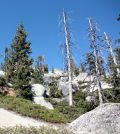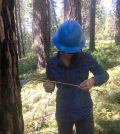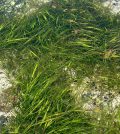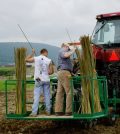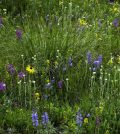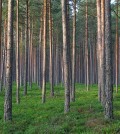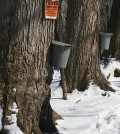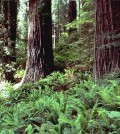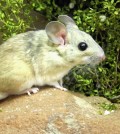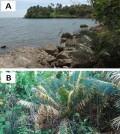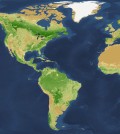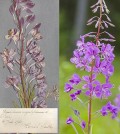Posts for tag "plants"
Vegetation Type Has Role In Future Sierra Nevada Stream Flows
Researchers at University of California, Santa Barbara, find changes in vegetation type due to climate warming will impact Sierra Nevada stream flows.
- Posted September 23, 2016
Douglas Fir Trees Threatened By Increasing Droughts
University of California, Davis, scientists find that Douglas fir trees in the West are consistently affected by drought conditions.
- Posted September 15, 2016
Little Narragansett Bay: Surveying Eelgrass With Underwater Video Camera, GIS
An effort to ground-truth aerial images of eelgrass in Little Narragansett Bay relies on a GIS map and an underwater video camera.
- Posted September 12, 2016
Massive Field Scanalyzer Studies Sorghum’s Energy Potential
University of Arizona researchers use a massive field scanalyzer, armed with hyperspectral imagers, to study different varieties of energy-rich sorghum.
- Posted July 25, 2016
Air Pollution Hurting U.S. Plant Diversity
Scientists at the University of Colorado have found that air pollution in the United States is having a harmful effect on our plant diversity, according to the Denver Post. They considered 15,000 forest, woodland and grassland sites...
- Posted May 11, 2016
Shrub Willow Crop At Penn State Yields Biomass Benefits
Penn State scientists harvest a crop of shrub willow, a biomass-friendly plant, while studying carbon and water flux surrounding it.
- Posted April 20, 2016
Rare Species, Once Lost, Are Hard To Replace
Rare species are irreplaceable when it comes to the functionality of ecosystems, say scientists at Florida International University. When removed, ecological processes may be altered with cascading consequences for other plants and animals, they have found. To...
- Posted April 15, 2016
Increased Atmospheric Nitrogen Leads To Plant Biodiversity Loss
In the past 100 years, agricultural and industrial activity have tripled the amount of nitrogen in the atmosphere, researchers have found. One of the effects of all of this excess nitrogen is a loss of biodiversity, as...
- Posted April 14, 2016
Plant Respiration Increase Due To Global Warming Likely Not As Large As Predicted
Like people and animals, plants also work harder as the temperature rises, respiring at higher rates. But as researchers from the Earth Institute at Columbia University explain in a release, plant respiration may not increase as much...
- Posted April 13, 2016
Cacti Can Help Clean Fish Farms
Scientists have turned to an unlikely natural source to clean up contaminated water, according to an Amercian Chemical Society press release. In order to eliminate pollution in fish farm water, researchers are using cacti. Farm fishing serves...
- Posted March 30, 2016
Tree Respiration Rates May Easily Adapt To Temperature Rises
In a predicted future of warmer global temperatures, researchers at the University of Minnesota had guessed that the respiration rates of trees, including some output of carbon dioxide, would increase by broad margins. But in putting the...
- Posted March 24, 2016
Researchers Assess Climate Change’s Effects On Maple Syrup
Some studies have attempted to assess the impacts of climate change on sap used to produce maple syrup, notably its flow and volume. But few investigations have looked at how climatic fluctuations may be impacting the quality...
- Posted March 1, 2016
Long-Term California Drought Impacts Redwood Ferns
Scientists at University of California, Santa Cruz, document how drought impacts redwood ferns, which make up much of the understory of redwood forests.
- Posted February 26, 2016
Warming May Spell Disaster For Woodrats Eating Toxic Plants
Woodrats find it harder to process creosote plants at higher temperatures. A tipping point seems to exist above which they will find it tough to thrive.
- Posted February 9, 2016
Typhoon Haiyan Disrupts Nutrient Cycling In Philippine Trees
When Typhoon Haiyan struck the Philippines in November of 2013, a team of researchers went out the next month to examine how one coastal tree, Cycas nitida, was affected by the storm. For many plants, leaves are...
- Posted February 8, 2016
Time To Re-examine Use Of Tree Ring Growth Estimates In Climate Models
Tree ring growth is a standard means of estimating past climate conditions for many researchers. However, interpretation of tree ring growth is based on different assumptions depending on which climate reconstruction approach is used. In a release...
- Posted February 4, 2016
Q&A With Ryan McEwan: Researching Invasive Shrubs, Stormwater Outfalls
Ryan McEwan, associate professor of ecology at the University of Dayton, talks with the Environmental Monitor about ongoing projects in his lab.
- Posted January 14, 2016
Survey Finds More Than 3 Trillion Trees Worldwide
Scientists in the Yale School of Forestry and Environmental Sciences have completed a survey of all the trees worldwide, according to National Public Radio. Their results are staggering when compared to previous estimates of the total tree...
- Posted January 8, 2016
Acclimation Of Plants Key To Improving Climate Change Models
Of the many pieces that comprise climate change models, plant photosynthesis and respiration have been two of the more uncertain components in the past. Photosynthesis and respiration equations typically reflected short-term temperature changes, but not long-term ones....
- Posted December 16, 2015
Higher Carbon Dioxide Levels Altered Plant Metabolism Over Past Century
Increased carbon dioxide levels have changed plant behavior as the globe has warmed up, including changes that are not readily apparent, such as metabolic differences which alter photosynthesis processes. According to a release from Umeå University, over...
- Posted December 15, 2015


